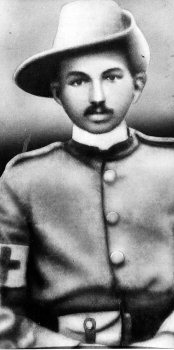 Main article: Gandhi's work in South Africa
Main article: Gandhi's work in South AfricaIn South Africa, Gandhi faced discrimination directed at Indians. He was thrown off a train at Pietermaritzburg after refusing to move from the first class to a third class coach while holding a valid first class ticket.[11]Traveling farther on by stagecoach he was beaten by a driver for refusing to travel on the foot board to make room for a European passenger.[12]He suffered other hardships on the journey as well, including being barred from several hotels. In another incident, the magistrate of aDurban court ordered Gandhi to remove his turban - which he refused to do.[13] These events were a turning point in his life, awakening him to social injustice and influencing his subsequent social activism. It was through witnessing firsthand theracism, prejudice and injustice against Indians in South Africa that Gandhi started to question his people's status within the British Empire, and his own place in society.
Gandhi extended his original period of stay in South Africa to assist Indians in opposing a bill to deny them the right to vote. Though unable to halt the bill's passage, his campaign was successful in drawing attention to the grievances of Indians in South Africa. He helped found the Natal Indian Congress in 1894,[4][11] and through this organization, he molded the Indian community of South Africa into a homogeneous political force. In January 1897, when Gandhi landed in Durban he was attacked by a mob of white settlers and escaped only through the efforts of the wife of the police superintendent. He, however, refused to press charges against any member of the mob, stating it was one of his principles not to seek redress for a personal wrong in a court of law.[4]
In 1906, the Transvaal government promulgated a new Act compelling registration of the colony's Indian population. At a mass protest meeting held in Johannesburg on 11 September that year, Gandhi adopted his still evolving methodology of satyagraha (devotion to the truth), or non-violent protest, for the first time, calling on his fellow Indians to defy the new law and suffer the punishments for doing so, rather than resist through violent means. This plan was adopted, leading to a seven-year struggle in which thousands of Indians were jailed (including Gandhi), flogged, or even shot, for striking, refusing to register, burning their registration cards or engaging in other forms of non-violent resistance. While the government was successful in repressing the Indian protesters, the public outcry stemming from the harsh methods employed by the South African government in the face of peaceful Indian protesters finally forced South African General Jan Christiaan Smuts to negotiate a compromise with Gandhi. Gandhi's ideas took shape and the concept ofsatyagraha matured during this struggle.
Some of Gandhi's early South African articles are controversial. On 7 March 1908, Gandhi wrote in the Indian Opinion of his time in a South African prison: "Kaffirs are as a rule uncivilized - the convicts even more so. They are troublesome, very dirty and live almost like animals."[14]Writing on the subject of immigration in 1903, Gandhi commented: "We believe as much in the purity of race as we think they do... We believe also that the white race in South Africa should be the predominating race."[15] During his time in South Africa, Gandhi protested repeatedly about the social classification of blacks with Indians, who he described as "undoubtedly infinitely superior to the Kaffirs".[16] It is worth noting that during Gandhi's time, the term Kaffir had a different connotation than its present-day usage. Remarks such as these have led some to accuse Gandhi of racism.[17]
Two professors of history who specialize in South Africa, Surendra Bhana and Goolam Vahed, examined this controversy in their text, The Making of a Political Reformer: Gandhi in South Africa, 1893–1914. (New Delhi: Manohar, 2005). They focus in Chapter 1, "Gandhi, Africans and Indians in Colonial Natal" on the relationship between the African and Indian communities under "White rule" and policies which enforced segregation (and, they argue, inevitable conflict between these communities). Of this relationship they state that, "the young Gandhi was influenced by segregationist notions prevalent in the 1890s."[18] At the same time, they state, "Gandhi's experiences in jail seemed to make him more sensitive to their plight...the later Gandhi mellowed; he seemed much less categorical in his expression of prejudice against Africans, and much more open to seeing points of common cause. His negative views in the Johannesburg jail were reserved for hardened African prisoners rather than Africans generally."[19]
Former President of South Africa Nelson Mandela is a follower of Gandhi,[20] despite efforts in 2003 on the part of Gandhi's critics to prevent the unveiling of a statue of Gandhi in Johannesburg.[17] Bhana and Vahed commented on the events surrounding the unveiling in the conclusion toThe Making of a Political Reformer: Gandhi in South Africa, 1893–1914. In the section "Gandhi's Legacy to South Africa," they note that "Gandhi inspired succeeding generations of South African activists seeking to end White rule. This legacy connects him to Nelson Mandela...in a sense Mandela completed what Gandhi started."[21]

No comments:
Post a Comment